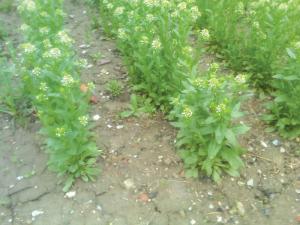2020 - Volume #44, Issue #3, Page #31
[ Sample Stories From This Issue | List of All Stories In This Issue | Print this story
| Read this issue]
Weed Seed Oil Being Used To Control Other Weeds
 |
What’s more, it’s also a potential biofuel source and can grow in and remove high levels of sodium in the soil.
“We extract the oil and apply it to various broadleaf and grass weed species in the greenhouse,” says Steve Reaume, manager, Research Operations, Lambton College. “It worked best on crabgrass and lambsquarter. Applied pre emerge, it reduced germination about 80 percent compared to control plots.”
Reaume says pennycress oil breaks down quickly and leaves no toxins in the soil.
“Pennycress for seed production is 60 to 65 days from planting to harvest,” says Reaume. “However, it only has to grow for a month as a cover crop to reduce sodium levels by 10 to 20 percent. Then it can be harvested for animal feed or treated like any other biomass. The leaves and stems will have a higher sodium level, but still less than marine biomass does.”
The challenge, according to Reaume, is getting the seed to germinate. The seed needs abrasion or freezing to open up the protective coating to absorb water. If not frozen at some point, it still has to go through a frost cycle. However, once it germinates, it can grow under almost any conditions.
Reaume is an advisor to an Ontario group planning a pennycress crushing facility. John Poel is a soil and crop consultant and one of the farmers experimenting with the crop. It was his seed that Reaume crushed for his experiments.
“We seeded some in the fall, but it didn’t grow until spring,” says Poel. “We weren’t able to harvest it before planting dry beans, so we worked it in. The dry beans did really well.”
Poel has planted a few acres in the spring and harvested in early fall. “It is beautiful stuff to harvest, very light and fluffy,” he says.
Poel sees the potential for a winter oil seed/cover crop. “We want to keep living root systems growing in the soil, and it would be great to make use of combines in the spring, as well as in the fall. It would also use leftover nitrogen when seeded down following corn.”
A variety of groups around the U.S and Canada are working with the oil seed plant. The University of Minnesota has several varieties in development but not yet ready for release. Western Illinois University established the Pennycress Resource Network and works closely with St. Louis based CoverCress, Inc. It has modified native pennycress to develop an improved version.
CoverCress’ claims include oil and high protein feed that fit markets similar to canola. They are promoting it as a cover crop that can be planted at corn harvest and harvested in time for full season soybean planting.
Contact: FARM SHOW Followup, Pennycress Resource Network (ph 309 298-1251; WB-Phippen@wiu.edu; www.wiu.edu/pennycress/index.php); or CoverCress Inc., 1100 Corporate Square Dr., Suite 135, St Louis, Mo. 63132 (ph 314 378-7556; info@covercress.com; www.covercress.com).

Click here to download page story appeared in.

Click here to read entire issue
To read the rest of this story, download this issue below or click here to register with your account number.




